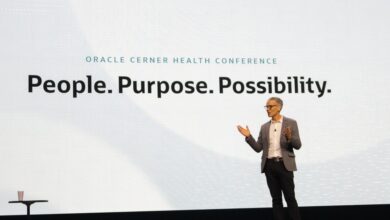Why Aspirus Health wants more merger partners

Aspirus Health continues to look for merger opportunities as it works toward a combination with St. Luke’s Duluth.
The Wausau, Wisconsin-based nonprofit health system, which has 17 hospitals in northern and central Wisconsin and Michigan’s Upper Peninsula as well as a health plan, expects to enter the Minnesota market after signing a letter of intent in July to merge& with St. Luke’s Duluth. CEO Matthew Heywood talked with Modern Healthcare about the integrated health system’s growth plans, strategies to improve access in rural communities and the competitive landscape. The interview has been edited for length and clarity.
Read more: Midwest hospital M&A market heats up, but faces policy hurdles
What is Aspirus Health’s operating model?
We’re trying to keep more care local. What many systems do in rural communities is pull care out, leave the bare, limited elements and tell everybody to drive to a centralized location. What we’re trying to do is get into the rural markets where we can have certain areas that have the scale to provide higher-level, high-quality services so patients don’t have to travel so far. There are not many rural healthcare systems doing that. It’s got its challenges in today’s world, but we’ve been able to eke out a decent margin in a very tough market.
What’s behind the proposed merger with St. Luke’s?
St. Luke’s region is contiguous to ours and they are a tertiary care provider. We can provide each other backup for tertiary care, which we didn’t have before. If our cardiovascular surgeons are busy in the operating room, the patients for much of our market can go to them. If they are backed up, their patients can come to us. We have some back-office system improvements that we could provide to St. Luke’s and we are very similar culturally.
Why is scale important?
You might think Aspirus becoming $2.5 billion to $3 billion is big. But when you look at it in healthcare, when you have four or five payers, they are multitudes more than $2.5 billion. Insurance companies in the last two or three years have denied more claims, changed their contracts midstream and are not getting their doctors in the system so they don’t pay up on time. So there is a huge delay in commercial payments. Also, Medicare Advantage programs are paying less than Medicare. We need some back-office scale so we can analyze our contracts and make sure we’re being paid fairly. You have to have some scale to at least compete in this world.
What’s the reason for the M&A activity among Midwest health systems?
In the Midwest, you have more of an aging population, you have less population growth and you have a higher percentage of Medicare Advantage payers. You want to have the scale and the back office to be more efficient, and now you have this problem with your revenue side getting weaker. Finally, your labor costs are going up more than in some higher-growth states. You sometimes look for friends who can help you get through the headwinds a little more effectively. That’s why you are seeing more activity in the Midwest.
As you integrate with other systems, how does your health plan arm fold in?
The government wants us to get into value-based care and figure out how to manage populations. The problem is governmental programs change so much. They’re hard to keep up with. We’ve been using our health plan as an incubator. We had identified 350 high-risk employees, helping us reduce the cost of care by $3 million by managing their care more effectively. We want to help St. Luke’s get that model in place. We still work with insurers in general, but many insurers don’t want to do value-based care products. And if they do, it’s very black box. It’s hard to understand. We try to do basic, traditional contracting with our general payers and use our own health plan to work on population health.
As a rural provider, how important are supplemental payments like the 340B drug discount program?
The 340B program, critical access hospital and rural health clinic status are critically important to delivering the care model that we’re trying to deliver. Without those supplemental payments, trying to do Medicare in rural America and bring orthopedic, surgical, cancer infusion and other services closer to patients’ homes is not viable.
What are the impacts of the looming Medicare sequestration and Pay As You Go Act cuts?
The share of Medicare and Medicaid business is increasing. The model of raising rates on the commercial side to offset governmental payers’ deficit is starting to fail. If you look at inflation staying in the 3% to 5% range and the labor market being tight, our costs are going up faster than our revenue. We’re preparing to cut costs, be as efficient as we can and try to get fair rates from commercial payers. But we see a tough next five years, where 2% margins are going to be considered doing great work.
What’s your outlook for Aspirus?
We’re looking for partners that help us build scale that allows us to care for the patient locally, and gives us that redundancy across contiguous markets. We were in talks with Riverview [Hospital] for years. We were in talks with Ascension for years. We were in talks with St. Luke’s for years. This model is something we were aware of, building to and talking to the parties [about] for many years, so it’s not like all of a sudden this is happening. …We want to make sure we are there for our patients in this tough environment. We aren’t going to do a deal just to do a deal. But if there’s something out there like St. Luke’s that’s going to help us be better in meeting that mission, we have to be willing to act on it.




